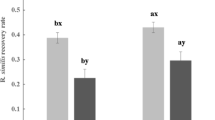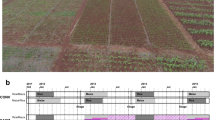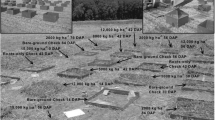Abstract
Yield increases of cereals following legumes in rotation have been previously reported for West Africa, but little progress has been made to explain the mechanisms involved. At four sites in Niger and Burkina Faso, field trials with pearl millet (Pennisetum glaucum (L.) R. Br.), cowpea (Vigna unguiculata (L.) Walp), sorghum (Sorghum bicolor (L.) Moench) and groundnut (Arachis hypogaea L.) were conducted from 1996 to 1998 to investigate the role of soil mineral nitrogen (Nmin), native arbuscular mycorrhizae (AM) and nematodes in cereal/legume rotations. Grain and total dry matter yields of cereals at harvest were increased by legume/cereal rotations at all sites. Soil Nmin levels in the topsoil were consistently higher in cereal plots previously sown with legumes (rotation cereals) compared with plots under continuous cereal cultivation. However, these rotation effects on Nmin were much larger with groundnut than with cowpea. Roots of rotation cereals also had higher early AM infection rates compared to continuous cereals. The dominant plant-parasitic nematodes found in all experiment fields were Helicotylenchus sp., Rotylenchus sp. and Pratylenchus sp. In sorghum/groundnut cropping systems, nematode densities were consistently lower in rotation sorghum compared to continuous sorghum. Continuous groundnut had the lowest nematode densities indicating that groundnut was a poor host for the three nematode groups. In millet/cowpea cropping systems with inherently high nematode densities, crop rotations barely affected nematode densities indicating that both crops were good hosts. These results suggest that on the nutrient poor Sudano-Sahelian soils of our study, total dry matter increases of rotation cereals compared with continuous cereals can be explained by higher Nmin and AM infection levels early in the season. The site-specific magnitude of these effects may be related to the efficiency of the legume species to suppress nematode populations and increase plant available N through N2-fixation.
Similar content being viewed by others
References
Bagayoko M, Mason S C, Traore S and Eskridge K M 1996 Pearl millet/cowpea cropping systems yield and soil nutrient levels. African Crop. Sci. J. 4, 453–462.
Baldock J O, Higgs R L, Paulson W H, Jackobs J A and Shrader W D 1981 Legume and mineral N effects on crop yields in several crop sequences in the Upper Mississippi Valley. Agron. J. 73, 885–890.
Bationo A, Mughogho S K and Mokwunye A U 1990 Agronomic evaluation of phosphate fertiliser in tropical Africa. In Management of Nitrogen and Phosphorus Fertilisers of Sub-Saharan Africa. Eds AU Mokwunye and PLG Vlek. pp 283–318. Martinus Nijhoff, Dordrecht, The Netherlands.
Bationo A, Lompo F and Koala S 1998 Research on nutrient flows and balances in West Africa: state-of-the-art. Agric. Ecosyst. Environ. 71, 19–35.
Buerkert A, Bationo A and Dossa K 2000 Mechanisms of residue mulch induced cereal growth increases in West Africa. Soil Sci. Soc. Am. J. (in press).
Buerkert A, Stern R D and Marschner H 1995 Post stratification clarifies treatment effects on millet growth in the Sahel. Agron. J. 87, 752–761.
Chase R G, Wendt J W and Hossner L R 1989 A study of crop growth variability in sandy Sahlian soils. In Soil, Crop and Water Management in the Sudano-Sahelian Zone. Eds C Renard, RJ Vandenbeldt and JF Parr. pp 229–240. Proceedings of an In116 ternational workshop, 11-16 January 1987. ICRISAT SahelianCenter, Niamey, Niger. ICRISAT, Patancheru, India.
Dickson D 1998 Peanut. In Plant Nematode Interactions. Eds KR Barker, GA Pederson and GL Windham. pp 523–566. ASACSSA-SSSA. 677 S, Madison, WI 53711, USA. Agronomy monograph no. 36.
Dodd J C, Arias I, Koomen I and Hayman D S 1990 The management of populations of versicular-arbuscular mycorrhizal fungi in acid-infertile soils of a savanna ecoystem. Plant Soil 122, 229–240.
Dodd J C and Jeffries P 1986 Early development of vesiculararbuscular mycorrhizas in autumn-sown cereals. Soil Biol. Biochem. 18, 149–154.
George E, Römheld V and Marschner H, 1994 Contribution of mycorrhizal fungi to micronutrient uptake by plants. In Biochemistry of Metal Micronutrients in the Rhizosphere. Eds JA Manthey, DE Crowley and DG Luster. pp 93–109. CRC Press, Boca Raton, Florida.
George E, Gorgus E, Schmeisser A and Marschner H 1996 A method to measure nutrient uptake from soil by mycorrhizal hyphae. In Mycorrhizas in Integrated Systems from Genes to Plant Development. Eds C Azcon-Aguilar and JM Barea. pp 535–538. European Community, Luxembourg.
Hooper D J 1984 Extraction of nematode from plant material. In Laboratory Methods for Work with Plants and Soil Nematodes. Ed. JF Southey. pp 59–80. Ministry of Agriculture, Fisheries and Food, London-HMSO.
Jain R K 1983 Investigations on pathogenicity and interaction of Meloidogyne incognita and Helicotylenchus dihystera infecting cowpea (Vigna unguiculata). Indian J. Agric. Res. 17, 33–36.
Johnson A W 1982 Managing nematode population in crop production. In Nematology in the Southern Region of the United States. Ed. RD Riggs. pp 193–203. Southern Cooperative Series Bulletin 276. Arkansas Agricultural Experiment Station, Fayetteville.
Johnson A W and Fassuliotis G 1991 Nematode parasites of vegetable crops. In Plant and Insect Nematodes. Ed. WR Nickle. pp 323–372. Marcel Dekker New york and Basel.
Johnson C N, Copeland P J, Crookston R K and Pfleger F L 1992 Mycorrhizae: possible explanation for yield decline with continuous corn and soybean. Agron. J. 84, 387–390.
Kormanik P P and McGraw A C 1984 Quantification of vesiculararbuscular mycorrhizae in plant roots. In Methods and Principles of Mycorrhizal Research. Ed. NC Schenck. pp 37–45. The American Phytopathological Society, St. Paul, Minn.
Lawes Agricultural Trust 1995. GENSTAT 5 Release 3.2 Reference Manual. Oxford University Press, Oxford, UK.
McSorley R and Gallaher R N 1991 Nematode population changes and forage yields of six corn and sorghum cultivars. Supplement to the J. Nematol. 23, 673–677.
McSorley R, Dickson D W, De Brito J A and Hochmuth R C 1994 Tropical rotation crops influence nematode densities and vegetable yields. J. Nematol. 26, 308–314.
Nicou R 1978 Etude de successions culturales au Sénégal: résultats et méthodes. Agron. Trop. 33, 51–61.
Ortas I, Harris P J and Rowell D L 1996 Enhanced uptake of phosphorus by mycorrhizal sorghum plants as influenced by forms of nitrogen. Plant Soil 184, 255–264.
Osseni B 1985 Les cultures associées à la culture de l'ananas: action sur le nematode Pratylenchus brachyururs, la croissance et le rendement de l'ananas 'Cayenne lisse'. Fruits 40, 709–718.
Pierce F J and Rice C W 1988 Crop rotation and its impact on efficiency of water and nitrogen use. In Cropping Strategies for Efficient use of Water and Nitrogen. Ed. WL Hargrove. pp 21–42. ASA Special Publication Number 51. ASA-CSSA-SSSA, Madison, WI. USA.
Rodríguez-Kábana R, Robertson D G, Wells L, Weaver C F and King P S 1991 Cotton as a rotation crop for the management of Meloidogyne arenaria and Sclerotium rolfsii in peanut. Supplement to J. Nematol. 23, 652–657.
Sharma R D and Medeiros A C 1982 Nematode associated with sweet sorghum in federal district of Brazil. Publicacao Sociedade Brazileira de Nematologia 6, 103–111.
Sharma S B and McDonald D 1990 Global status of nematode problems of groundnut, pigeonpea, chickpea, sorghum and pearl millet, and suggestion for future work. Crop Protection 9, 453–458.
Shipton P J 1977 Monoculture and soil born plant pathogen. Ann. Rev. Phytopathol. 15, 481–487.
Sivakumar MV K 1989 Agroclimatic Aspect of Rainfed Agriculture in the Sudano-Sahelian zone. In Soil, Crop and Water Management in the Sudano-Sahelian Zone. Eds C Renard, RJ Van Den Beldt and JF Paar. pp 17–38. Proceedings of an International workshop, 11-16 January 1987. ICRISAT, Patancheru, Andhra Pradesh India.
Stoop W A and Van Stavern J P 1981 Effects of cowpeas in cereal rotations on subsequent crop yields under semi-arid conditions in Upper Volta. In Biological Nitrogen Fixation Technology for Tropical Agriculture. Eds PC Graham and SC Harris. pp 653–657. CIAT, Cali, Colombia.
Thompson J P, Brennan P S, Clewett T G and O'Reilly M M 1994 Tolerance and resistance to Pratylenchus thornei. In Proceedings of the 7th assembly of the Wheat Breeding Society of Australia. pp 213–216. Adelaide, Australia.
Todd R L, Giddens J E, Kral DM and Hawkins S L 1984 Microbial-Plant Interactions. In ASA Special Publications Number 47. Proc. Symp. Proc. Symp. SSSA, ASA, CSSA, Madison, WI. USA.
Trevathan L E, Cuarezma-Teran T A and Gourley L M 1985 Relationship of plant-nematodes and edaphic factors in Colombian grain sorghum production. Nematropica 15, 145–153.
Turco R F, Bischoff M, Breakwell D P and Griffi D R 1990 Contribution of soil born bacteria to the rotation effects in corn. Plant Soil 122, 115–120.
Wildermuth G B, Thompson J P and Robertson L N 1997 Biological change: diseases, insects and beneficial organisms. In Sustainable Crop Production in the sub-tropics: an Australian Perspective. Eds AL Clarke and PB Wylie. pp 112–130. Brisbane, Australia.
Author information
Authors and Affiliations
Rights and permissions
About this article
Cite this article
Bagayoko, M., Buerkert, A., Lung, G. et al. Cereal/legume rotation effects on cereal growth in Sudano-Sahelian West Africa: soil mineral nitrogen, mycorrhizae and nematodes. Plant and Soil 218, 103–116 (2000). https://doi.org/10.1023/A:1014957605852
Issue Date:
DOI: https://doi.org/10.1023/A:1014957605852




